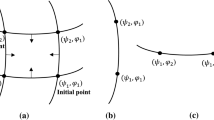Abstract
This paper proposes a Markov model of link connectivity for mobile ad hoc networks. Under a random behavior, the model provides a unified approach to describe many different mobility models including entity mobility models and group mobility models. Using the model, we can predict the time dependence of link connectivity, and estimate a settling time for which node movements are considered in a transient state. We verify the model with the simulation results of four different mobility models using a global connectivity and a link duration distribution.
Similar content being viewed by others
References
F. Bai, N. Sadagopan and B. Krishnamachari, Modeling path duration distributions in manets and their impact on reactive routing protocols, IEEE Journal on Selected Areas in Communications 22(7) (2004) 1357–1373.
D.M. Blough, G. Resta and P. Santi, A statistical analysis of the long-run node spatial distribution in mobile ad hoc networks, in: Proceedings of the ACM MSWiM (2002).
R.C. Dorf and R.H. Bishop, Modern Control System (Addison Wesley, 1995).
Y. Han, R.J. La and A.M. Makowski, Distribution of path durations in mobile ad-hoc networks-palm’s theorem at work, in: 16th International Teletraffic Congress Specialist Seminar on Performance Evaluation of Wireless and Mobile System (2004).
X. Hong, M. Gerla, G. Pei and C.C. Chiang, A group mobility model for ad hoc wireless networks, in: Proceedings on ACM International Workshop on Modeling and Simulation of Wireless and Mobile Systems (MSWiM) (1999).
V. Kawadia and P.R. Kumar, Power control and clustering in ad hoc networks, in: Proceedings of the 21st Annual Joint Conference on IEEE Computer and Communications Sociology (INFOCOM 2003), pp. 459–469.
D.S. Kim and S.K. Hwang, Behavioral group mobility model in ad hoc wireless networks, in: 9th International Conference on Cellular and Intelligent Communications (2004).
A.B. McDonald and T. Znati, A mobility based framework for adaptive clustering in wireless ad-hoc networks, IEEE Journal on Selected Areas in Communications 17(8) (1999).
W. Navidi and T. Camp, Stationary distributions for the random waypoint mobility model, IEEE Transactions on Mobile Computing 3(1) (2004).
G. Resta and P. Santi, An analysis of the node spatial distribution of the random waypoint mobility model for ad hoc networks, in: Proceedings on the Second ACM International Workshop on Principles of Mobile Computing (2000), pp. 44–50.
W. Su, S.-J. Lee and M. Gerla, Mobility prediction and routing in ad hoc wireless networks, International Journal of Network Management 11(1) (2001) 3–30.
J. Tsumochi, K. Masayama, H. Uehara and M. Yokoyama, Impact of mobility metric on routing protocols for mobile ad hoc networks, in: Proceedings of the IEEE Pacific Rim Conference on Communications, Computers and Signal Processing (2003), pp. 322–325.
K.H. Wang and B. Li, Group mobility and partition prediction in wireless ad-hoc networks, in: Proceedings of the IEEE International Conference on Communications (ICC) (2002).
J. Yoon, M. Liu and B. Noble, Random waypoint considered harmful, in: Proceedings of the 21st Annual Joint Conference on IEEE Computer and Communications Sociology (2003), pp. 1312–1321.
M.M. Zonoozi and P. Dassanayake, User mobility modeling and characterization of mobility patterns, IEEE Journal on Selected Areas in Communications 15(7) (1997) 1239–1252.
Author information
Authors and Affiliations
Corresponding author
Additional information
This research was supported in part by the National Science Foundation under grant CCF-0514975.
Seok K. Hwang received the B.S. degree in Control and Instrumentation Engineering from Korea University, Korea in 1998. He received the M.S. degreeand the Ph.D.degree in Electrical Engineering at POSTECH, Korea in 2000 and 2006, respectively.His research interests include intelligence controls and computational intelligence for multi-objective optimization problems. He is working on multimedia communication as a senior researcher at Korea Telecom since 2006.
Dongsoo Stephen Kim received the B.S. degree from Korean University in 1987, the M.S. degree in computer science from the University of Texas in 1994, and the Ph.D. degree in computer science and engineering from the University of Minnesota in 1998. During 1986–2002, he was a Research Associate at Electronic and Telecommunication Research Institute, Taejon, Korea. In 1998–2000, he was a project manager at Megaxess Inc., Germantown, Maryland. He joined the Department of Electrical and Computer Engineering at Purdue School of Engineering and Technology, IUPUI in 2000. His current research interests include mobile wireless networks, mobility modeling, traffic modeling, and performance evaluation of communication networks.
Rights and permissions
About this article
Cite this article
Hwang, S.K., Kim, D.S. Markov model of link connectivity in mobile ad hoc networks. Telecommun Syst 34, 51–58 (2007). https://doi.org/10.1007/s11235-006-9025-x
Received:
Revised:
Accepted:
Published:
Issue Date:
DOI: https://doi.org/10.1007/s11235-006-9025-x




